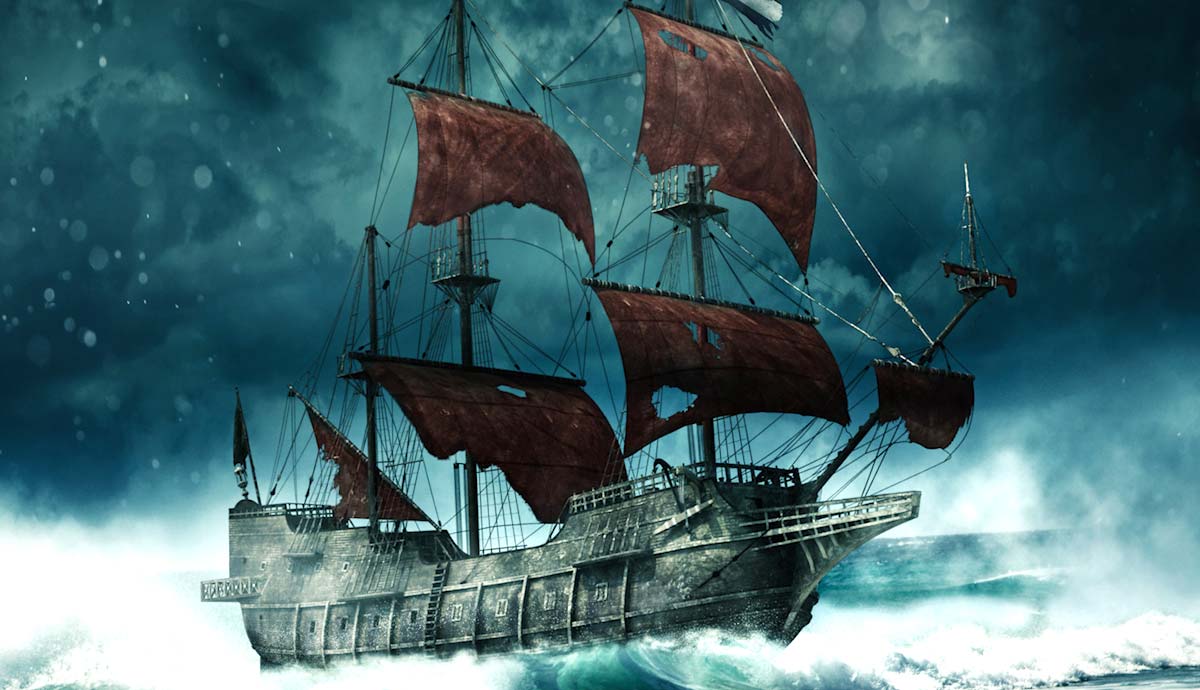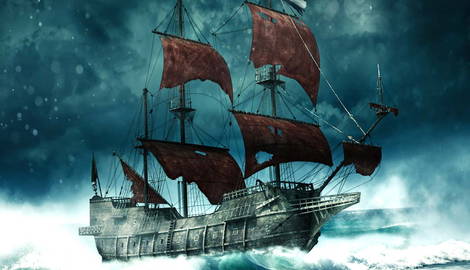
The ocean is full of the unknown. So little has been explored, yet it has been one of mankind’s chief assets since early human history. The ocean’s waterways were a vital resource that allowed countries and individuals to grow in wealth, power, and reputation. However, for some, the ocean took away more than it gave. Such losses could be attributed to massive storms, run-ins with sea creatures, or piracy. Still, sometimes in history, the ocean stole lives without any sort of explanation. This is what happened in the mysterious case of the Mary Celeste.
The Mary Celeste: A Ship’s History

Originally christened the Amazon, the Mary Celeste was built in Nova Scotia in 1861. It was a two masted brigantine, a type of boat designed for maximum speed with more square footage of sail than other similarly sized ships of the era. It traveled across the Atlantic Ocean several times as a merchant ship, as well as the Mediterranean and Caribbean Seas. It changed ownership numerous times, and after renovations and repairs, it was eventually renamed. The Mary Celeste was 30 meters in length and weighed 198 metric tons.
In 1872, a man named Captain Benjamin Briggs invested in the Mary Celeste, and purchased shares with his savings. He oversaw the renovations and planned to take command of the ship on her first voyage under her new moniker.
Setting Sail

Briggs gathered a trusted crew to help him sail the Mary Celeste to their destination, Genoa, Italy, from New York. Due to the efficiency of the brigantine style, the ship could be managed with a relatively small crew. A crew of seven joined Briggs on the ship. His first mate, Albert Richardson, had sailed with him previously. In addition to the crew, Brigg’s wife, Sarah, and their two year old daughter, Sophia, also joined him on the ship. Their seven year old son, Arthur, stayed behind in New York, as he had his education to attend to.

The boat’s cargo was 1,701 barrels of denatured alcohol. This type of ethanol had additives put into the barrels to make it not only unappetizing, but poisonous. This was to prevent anyone from becoming tempted to imbibe in the cargo on the voyage, and was a common practice among manufacturers. The alcohol would go on to be used in industrial processes such as the creation of perfume, as a solvent, and as cleaning fluid.
The cargo was loaded on October 20, 1872, but the crew would be unable to set sail until November 7 due to poor weather conditions. The night before setting sail, Briggs dined with David Morehouse, the captain of another brigantine, the Dei Gratia, which planned to follow a route similar to the Mary Celeste’s just over a week later.

After setting sail, the crew would continue to contend with “heavy weather,” according to the captain’s log. They reached the Azores, islands west of Portugal, on November 25. This was the last recorded information from the crew of the Mary Celeste.
Abandoned

On December 5th, Captain Morehouse was piloting the Dei Gratia about 400 miles east of the Azores when his crew spotted a ship that seemed to be adrift. They soon discovered that the vessel was the Mary Celeste, which shocked Morehouse–he was certain that the ship should have been safely docked in Genoa by then. They altered their course and sent a boarding party to the Mary Celeste. What they found was more than mysterious.

No one, living or dead, was found aboard the ship. All ten of the crew and captain’s family had vanished without a trace. Just over one meter of water flooded the bottom of the ship, but it was far from in danger of sinking. One of the two pumps used to remove water had been disassembled. The cargo of denatured alcohol appeared to be mostly undamaged. The single lifeboat that had been aboard the boat was gone, but all of the crew’s belongings seemed to be intact in their quarters.

There seemed to be enough food and water aboard to last those who had been aboard six months. The only major damage to the ship seemed to be the compass, which had its glass front smashed, and the fact that the interior of some of the cabins were wet. The ship’s log was intact, where the last entry dated November 25 was observed. The only things that seemed to be missing from the ship were its people, the captain’s navigational instruments, and his personal papers.

After determining that no one was aboard the ship or nearby and unsure what had become of the people aboard, the Dei Gratia crew decided to tow the Mary Celeste approximately 800 miles to Gibraltar. There, a court would determine if the crew was entitled to a salvage payment on behalf of the ship’s owner’s insurance company.
The lawyer in charge of the salvage hearing had some suspicions that the crew of the Dei Gratia was involved in the disappearance of the ten people aboard the Mary Celeste, but after a three-month investigation, no evidence of their involvement was proven, and they received a payment. However, the payment was only one-fifth of the Mary Celeste’s insured value, which indicated that there was still lingering suspicion regarding the Dei Gratia crew.
Speculation

What happened to the people aboard the Mary Celeste? That question has yet to be answered, over 150 years later. Of course, theories abound, but no one has been able to conclusively prove the fate of the crew and captain’s family. No bodies have ever been found, and no evidence of their actions after November 25 has been discovered. Here are some of the most popular theories about what happened to those sailing aboard the ghost ship.
1. Foul Play?

Foul play was the earliest theory surrounding the disappearance of those aboard the Mary Celeste. Suspicion surrounded the crew of the Dei Gratia as they stood to gain from the salvage fees. However, there are some problems with this supposition. Firstly, the captains of the two ships were known to be on pleasant terms. Would Morehouse really have hurt his friend for money? Next, the second ship would have had to make haste to catch the Mary Celeste, as it left port eight days behind Briggs and his crew.

It was postulated that other offenders could have taken advantage of the Mary Celeste’s passengers. Pirates may have been active in the area at the time of the ship’s passage. Cinema has explored the possibility of murder, including one of the sailors turning on the crew, such as 1935’s The Mystery of the Mary Celeste, in which the offender is played by Bela Lugosi.
Sir Arthur Conan Doyle, famed Sherlock Holmes author, took a fictional look at the story with J. Habakkuk Jephson’s Statement in January of 1884. In this short story, the vessel is referred to as the Marie Celeste and tells of a former slave exacting revenge on the crew. However, Doyle’s writing was so effective that many thought it was reporting on factual events.
2. Dispersed in a Lifeboat?

Some historians believe that since the lifeboat was missing, the crew must have absconded on their own, and then something happened that caused them to be lost once they were adrift. It has been suggested that the amount of water coming into the hold alarmed the crew, especially with the appearance of a broken pump, though the ship was still seaworthy.
There is also the possibility that some of the alcohol, a volatile substance, may have exploded or otherwise alarmed the crew so that they felt it prudent to get off the ship. If that was the case, why had they left so many of their belongings behind? If they left on their own free will, they did so in a hurry, taking only navigational instruments.
3. Natural Phenomena?

Though the ship itself was largely intact, some wonder if the crew was swept away by a powerful natural phenomenon. A waterspout is the most commonly suggested culprit. Similar to a tornado but made entirely of water, these whirling columns are usually correlated with severe thunderstorms. Since the Mary Celeste had been battling severe weather, the appearance of a waterspout would not be unheard of. This might also explain the water damage inside the cabins and the water in the hold.
4. Something Else?

Of course, there is no limit to the theories that have arisen in the decades since the disappearance of the people aboard the Mary Celeste. Suggestions have included an attack by a sea monster or giant squid, alien intervention, a failed insurance fraud scheme, and more. But again, a lack of evidence leaves the world wondering what actually happened to Briggs, his family, and the seven-man crew.
The Future of the Mary Celeste

The Mary Celeste would return to sailing in 1873. However, the ship was now seen as cursed and was not a profitable venture for its owners. In 1885, it was wrecked off the coast of Haiti in an event that was later determined to be intentional in a case of insurance fraud.
Arthur Briggs, the only surviving member of his immediate family, became a ward of his uncle. He would eventually marry and have two sons, making a career as a commercial bookkeeper.

The world is still left to wonder at the fate of the ten people who boarded the Mary Celeste in 1872. It has joined the ranks of dozens of other “ghost ships” that have haunted the oceans over history. While its story has been largely forgotten amid other bits of maritime tragedy and intrigue, the tale still puzzles historians and amateur sleuths alike.











